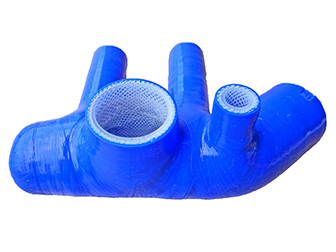The so-called multi-row
silicone hose refers to a product in which only different systems work in one component and do not touch and interfere with each other. For example, a single-hole silicone hose (4*6) is regarded as an independent working system as a water-passing pipe. Now it is necessary to introduce gas into the terminal and also need a pipe (because water and gas cannot be introduced together). It is a single working system, which consists of two separate silicone flexible pipes. In order to avoid repeated production,
silicone hose manufacturers will adopt integrated extrusion molding. Two separate silicone hoses are extruded in a mold. The output is a multi-row silicone hose, of course, it can also be called a multi-row silicone hose by extrusion molding from three or more separate silicone hoses.


At this stage, the multi-row silicone hoses circulating in the market are generally divided into two types: regular and irregular. Regular multi-row silicone hoses are composed of each silicone hose whose size and wall thickness requirements are the same, such as a single silicone hose. It is a 4*8 specification, and the remaining few silicone hose specifications are all this specification, and this kind of regular multi-row silicone hose is generally shaped in a "8" shape or multiple "8" shapes side by side. The dimensions of the inner and outer diameters are consistent. Generally, there are more drainage areas. In most cases, it is easier to produce regular multiple rows of silicone hoses, because their dimensions are consistent and it is convenient for manufacturers to debug equipment and facilitate mass production.
The principle of irregular multi-row silicone hoses is that the individual silicone hoses are not connected to each other, and the customer has precise and strict requirements for the gas or liquid diversion of each pipeline, that is, the flow rate needs to be controlled, so the size of each pipeline is equal. There are differences. Some single silicone hoses are relatively large in size, and some are relatively small. Each silicone hose is different but needs to be independent. The silicone hose of hole A drains water, and the silicone hose of hole B drains the liquid. The flow rate of the liquid should be 1.5 times that of water. At this time, the silicone hose of hole A needs to be reduced by 1.5 in the same proportion as the silicone hose of hole B. This kind of customer requirements can be met. The reason why there are irregular multiple rows of silicone hoses is because each individual silicone hose has special requirements, and most of them are flow control. Of course, there are exceptions. The reason why individual customers use irregular multiple rows of silicone hoses is because the other hole is not used to divert the product, but to cover some wiring harnesses (such as wires, etc.). I think this is nothing special. The required design is also relatively convenient. Generally, it is enough to make it a little larger than the wire harness. This will lead to the inconsistency of the left and right silicone hoses and the formation of non-standard
multi-row silicone hoses.
SUNRISE can produce all kinds of performance silicone hose for your special use. We accept custom orders! If you have any questions, please contact us.
Related Products: Fuel Cell Silicone Hose,FKM Reinforced Silicone Hose

